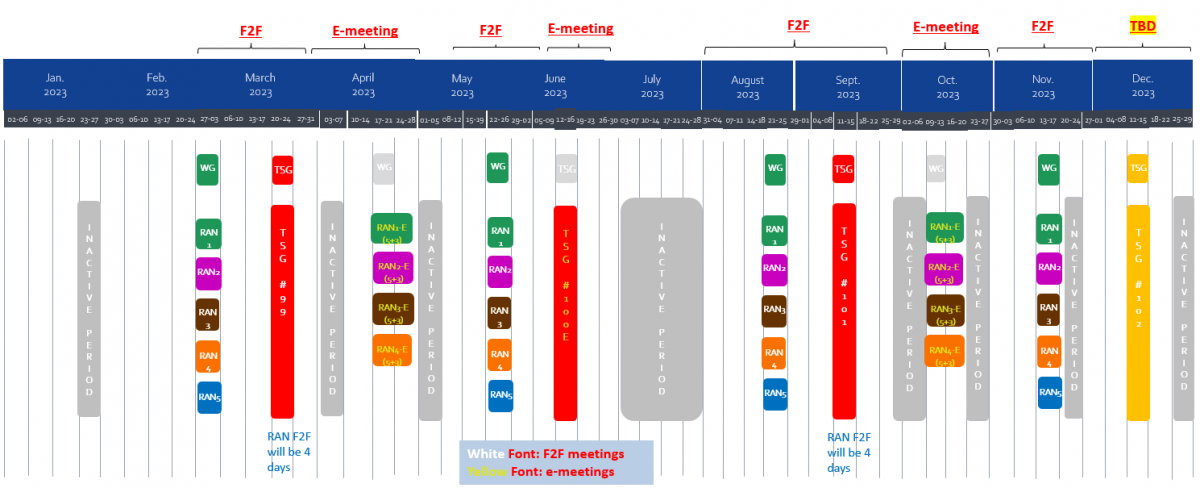
Summary Report from 3GPP plenaries (mainly RAN) #97e (Electronic meeting, 12 - 16 September 2022)
Summary Report from 3GPP plenaries (mainly RAN) #97e (Electronic meeting, 12 - 16 September 2022)
Hans van der Veen, NEC Laboratories Europe GmbH
General
- Rel-17 core functionality is now frozen (last 2 RAN exceptions were completed; SA/CT Stage 3 work was also completed)
- Most, but not all, remaining Rel-17 RAN4 performance Work Items for non-spectrum topics were completed
- RAN recommends that the September specifications (including ASN.1) shall be regarded as the Rel-17 baseline
- No new Rel-18 work was allowed in RAN, except:
- RAN-plenary level study on Ambient IoT
- Two normative follow-up Work Items on earlier studies:
- Network-controlled repeaters (NCR)
- Reduced Capability UEs (RedCap)
- Continuation of MIMO OTA and TRP/TRS work
- No upscoping of existing Rel-18 work was allowed in RAN
RAN Meeting planning (Endorsed: RP-222604)

The above is the 2023 RAN meeting planning. Note: The Rel-18 timeline was originally decided under the assumption of mostly F2F meetings. Because the reality is still a significant number of electronic meetings, this topic will be re-discussed in December.
Rel-17
Rel-17 Planning and progress (RAN2/3/4 core work completed; SA/CT Stage 3 work completed; September is Rel-17 baseline)
Stage 1: frozen December 2019 with exceptions; Stage 1 work completed by June 2020
RAN work package: approved December 2019
Stage 2: frozen June 2021 with exceptions; Stage 2 work completed by June 2022
RAN1: frozen December 2021
RAN2/3/4 core functionality: frozen March 2022 with exceptions; RAN2/3/4 core work completed by September 2022
Stage 3: frozen March 2022 with exceptions; Stage 3 work completed by September 2022
ASN.1 and open APIs: frozen June 2022; September 2022 version of specifications is recommended as Rel-17 baseline
RAN4: Most performance WIs were closed. Still open non-spectrum WIs with target date December 2022 are (% completion):
- Perf.: Extending current NR operation to 71GHz (45%)
- Perf.: Further enhancements on MIMO for NR (85%)
- Perf.: NR coverage enhancements (90%)
- Perf.: Support of reduced capability NR devices (75%)
- Perf.: Enhanced IIoT and URLLC support for NR (85%)
- Perf.: Solutions for NR to support non-terrestrial networks (NTN) (35%)
- Perf.: NR small data transmissions in INACTIVE state (70%)
- Perf.: NR repeaters (80%)
Closed Rel-17 Work Items and Study Items (excluding spectrum-related and conformance testing)
Rel-17 NR
- Core: Extending current NR operation to 71GHz
- Core: Introduction of 900MHz NR band for Europe for Rail Mobile Radio (RMR)
- Perf.: NR sidelink enhancement
- Perf.: NR Positioning Enhancements
- Perf.: UE Power Saving Enhancements for NR
- Perf.: Further Multi-Radio Dual-Connectivity enhancements
- Perf.: Enhancements to IAB for NR
- Perf.: NR Sidelink Relay
- Perf.: Further enhancement on NR demodulation performance
- Perf.: Multiple Input Multiple Output (MIMO) Over-the-Air (OTA) requirements for NR UEs
- Perf.: Introduction of UE TRP (Total Radiated Power) and TRS (Total Radiated Sensitivity) requirements and test methodologies for FR1 (NR SA and EN-DC)
- Perf.: Enhanced NR support for high speed train scenario for frequency range 1 (FR1)
- Perf.: NR support for high speed train scenario for frequency range 2 (FR2)
- Perf.: RF requirements enhancement for NR frequency range 1 (FR1)
- Perf.: Further enhancements of NR RF requirements for frequency range 2 (FR2)
- Perf.: Further RRM enhancement for NR and MR-DC
- Perf.: NR and MR-DC measurement gap enhancements
Rel-17 LTE
- Perf.: Additional enhancements for NB-IoT and LTE-MTC
Rel-17 RAN Work Item Summaries (descriptions of features in the release after the work has actually finished)
- RP-222478 Extending current NR operation to 71GHz
- RP-221946 Solutions for NR to support non-terrestrial networks (NTN)
- RP-222107 Introduction of bandwidth combination set 4 (BCS4) for NR
Rel-17 SA Work Item Summaries (descriptions of features in the release after the work has actually finished)
- SP-220841 Management data collection control and discovery (MADCOL)
- SP-220897 5G System Enhancement for Advanced Interactive Services (5G_AIS)
- SP-220899 Enhancement to the 5GC LoCation Services-Phase 2 (5G_eLCS_ph2)
- SP-220967 Integration of satellite components in the 5G architecture (5GSAT_ARCH)
- SP-220974 Enhanced Relays for Energy eFficiency and Extensive Coverage (REFEC)
- SP-220975 Charging aspects of Edge Computing (EDGE_CH)
- SP-220976 Enhancement of Management Data Analytics Service (eMDAS)
- SP-220977 Enhancement of 5G performance measurements and KPIs (ePM_KPI_5G)
Rel-17 NR: Small data transmissions (Summary: RP-222586)
No further work will be done to enable SDT on NR-U as part of Rel-17.
Rel-17 NR: MIMO-OTA (Approved revised WID: RP-222348; Approved WI: RP-222668; Summary: RP-222587)
The unfinished performance part objective, specifying FR2 MIMO OTA performance requirements was moved from Rel-17 to Rel-18 and Rel-17 MIMO OTA WI was closed. The Rel-18 WI was approved.
Rel-17 NR: TRP - TRS (Approved revised WID: RP-222269; Approved WI: RP-222669; Summary: RP-222588)
TS 38.161 was approved. The Rel-17 WI was closed. A new Rel-18 WI was approved.
Rel-17 NR: 4Rx for 6GHz (Summary: RP-222684)
Define band n104 requirements with 4Rx as baseline. RAN4 to perform a study on any possible 2Rx exception (as done for 2Rx exception for automotive) and, if confirmed, identify the necessary specification impact (e.g. requirements, signalling) for the 2Rx exception to be used.
Rel-17 NR: Coverage enhancement (Approved company CR: RP-222609; Summary: RP-222592)
Frequency hopping pattern for PUSCH with demodulation reference signal (DMRS) bundling is determined by only the physical slot index and is independent from system frame number (SFN). Discussions in RAN1 on UE behaviour of restarting DMRS bundling will continue. WGs are to continue with their work to resolve the issue of supporting DMRS bundling in case of UL operation over multiple carriers before RAN#98e under the assumption of no RAN1 specification change.
Rel-18
Rel-18 Planning (no changes: no milestones in September 2022)
Stage 1: frozen December 2021 without exceptions
RAN1/2/3 work package: approved December 2021
RAN4 work package: approved March 2022
Stage 2: freezing target March 2023
RAN1: freezing target September 2023
RAN2/3/4 core functionality: freezing target December 2023
Stage 3: freezing target December 2023
ASN.1 and open APIs: freezing target March 2024
RAN4: freezing target June 2024
Closed Rel-18 Work Items and Study Items (excluding spectrum-related and conformance testing)
Rel-18 NR
- SI: Study on NR network-controlled repeaters
- SI: Study on Further NR RedCap (reduced capability) UE complexity reduction
- SI: Study on Enhancement for resiliency of gNB-CU-CP
Rel-18 NR: Irregular bandwidths (Approved revised SID: RP-222618; Summary: RP-222571)
SIB1 signalling and channel bandwidth configuration will be discussed in RAN4#104bis (October meeting). Discussion on irregular channel methods will resume when all core open issues are clarified.
Rel-18 NR: Sidelink positioning (Approved revised SID: RP-222616; Summary: RP-222572)
Checkpoint on unlicensed spectrum was deferred to RAN#98e. No work on SL positioning in unlicensed spectrum is expected in the WGs prior to RAN#98e. FR2 was not excluded from the SL positioning study at RAN#97e.
Rel-18 NR: Low-power WUS (Approved revised SID: RP-222644; Summary: RP-222574)
The Rel-18 study on low-power WUS/WUR is for NR only and LTE NB IoT/MTC is not in scope of the SI.
Rel-18 NR: FR2 OTA testing enhancements (Approved revised SID: RP-222652; Summary: RP-222577)
The angular separations between angles of arrival (AoAs) are FFS. The testability of angular separations between AoAs need to be studied for UE RRM testing. Whether or not to include the case of transmitting simultaneously is to be revisited in RAN#98e.
Rel-18 NR: Multi-carrier enhancements (Approved revised WID: RP-222251; Summary: RP-222672)
The number of Timing Advance Groups (TAGs) is limited to up to 2 for both 2 bands switching and more than 2 bands switching cases. RAN1/2 discussion on UL Tx switching with 2 TAGs can be triggered by RAN4 but no RAN1 spec impact is expected.
Any optimization for unlicensed spectrum operation for designing multi-cell PUSCH/PDSCH scheduling in Rel-18 is deprioritized. Enhanced Type-2 HARQ-ACK codebook is not supported for the multi-cell PUSCH/PDSCH scheduling in Rel-18.
Type-1 HARQ-ACK codebook is supported only for the case where co-scheduled cells by a DCI format 1_X have same SCS/carrier type/duplex mode in Rel-18. Additional restriction(s) can be discussed in RAN1.
Configuring more than one scheduling cell for DCI format 0_X/1_X for each scheduled cell is not supported for the multi-cell PUSCH/PDSCH scheduling in Rel-18.
Following aspects are excluded from multi-cell PDSCH/PUSCH scheduling in Rel-18:
- SCell schedules multiple cells including P(S)Cell
- Different SCS among co-scheduled cells
- Different carrier type (licensed or unlicensed, FR1 or FR2-1 or FR2-2) among co-scheduled cells
- Configuration of both multi-cell PDSCH/PUSCH scheduling and multi-TRP for a scheduled cell
- Support for any sidelink scheduling
- PCell schedules multiple cells by DCI format 0_X/1_X when a sSCell is configured to schedule PCell
Rel-18 NR: Sidelink evolution (Approved revised WID: RP-221938; Summary: RP-222674)
For the co-existence objective, RAN1 continues the work on dynamic resource pool sharing based on existing agreements and WID with high priority for Type A devices and operating combination A.
The FR2 objective starts from RAN#97e and focuses only on updating evaluation methodology in 4Q 2022. RAN#98e will determine whether to continue the study or study+specification work for FR2 until the end of Rel-18.
The CA objective continued to be put on-hold. RAN#98e will determine whether it can be started.
Rel-18 NR: Mobility enhancements (Approved revised WID: RP-222332; Summary: RP-222640)
RAN3 can discuss "Avoiding an unnecessary MN-to-target-SN-RTT for cases when the source SN config changes that does not impact the target SN config." If needed, the WID can be further updated in RAN#98e.
Rel-18 NR: Non-Terrestrial Networks enhancements (Approved revised WID: RP-222654; Summary: RP-222653)
The reference scenario for definition of uplink coverage enhancements for NTN was updated. RAN#99 will discuss:
- Whether the Rel-18 PRACH enhancements (defined as part of Rel-18 NR coverage enhancements WI ) are sufficient to address the coverage gaps with respect to NTN specifics (i.e. agreed at RAN1#109-e/RAN1#110, under NR_NTN_enh WI) and whether additional PRACH enhancements need to be specified;
- DL channel enhancements for NTN coverage (including the need);
- Decision to specify High power UE (e.g. 26 dBm Tx power) for NTN FDD FR1 band(s), i.e. Rx/Tx requirements (This includes the study of relevant coexistence scenarios) [RAN4].
Rel-18 NR: Mobile IAB (Approved revised WID: RP-222671; Summary: RP-222584)
The NOTE on complexity of a mobile IAB-node connecting to an intermediate node vs. directly to the donor was removed. The mobile IAB node can connect to a stationary (intermediate) IAB-node. Optimizations specific to the scenarios, where the mobile IAB-node connects to a stationary (intermediate) IAB-node, or where it directly connects to a IAB-donor-DU are de-prioritized. The mobility of dual-connected IAB-nodes is down-prioritized. Solutions should support UE HO and UE DC.
Rel-18 NR: Measurement Gap Enhancement (Approved revised WID: RP-222337; Summary: RP-222585)
Gaps configured for NTN are precluded. Prioritization among other possible combinations of pre-configured MG, concurrent MG, NTN gaps and Network-Controlled Small Gap (NCSG) can be discussed after RAN#99. This WI does not include any interworking with MUSIM gaps.
Approved Rel-18 Work Items and Study Items (excluding spectrum-related and conformance testing)
- RP-222685 SI: Study on Ambient IoT
Keywords: Study new 3GPP IoT technology, suitable for deployment in a 3GPP system, which relies on ultra-low complexity devices with ultra-low power consumption for the very-low end IoT applications; Address use cases and scenarios not fulfilled by existing 3GPP LPWA IoT technology; Do not prioritize aspects that require coordination with SA; SA1 requirements on relevant use cases shall be taken into consideration.
- RP-222673 WI: NR Network-controlled Repeaters
Keywords: Specify NCR with following scenarios and assumptions: Inband RF repeaters used for extension of network coverage on FR1 and FR2 bands based on NCR model in TR38.867; For only single hop stationary NCR; Transparent to the UE; NCR can maintain gNB-repeater link and repeater-UE link simultaneously.
- RP-222675 WI: Enhanced support of reduced capability NR devices
Keywords: Power saving/energy efficiency enhancement: Enhanced eDRX in RRC_INACTIVE (>10.24s); Complexity/cost reduction: Further reduced UE complexity in FR1; No overlap with LPWA use cases; Coexistence with non-RedCap UEs and Rel-17 RedCap UEs should be ensured; All applicable duplex modes unless otherwise specified.
- RP-222669 WI: Enhancement of UE TRP (Total Radiated Power) and TRS (Total Radiated Sensitivity) requirements and test methodologies
Keywords: Enhancements of anechoic-chamber based test methodology; Study/specify reverb-chamber based test methodology to support SA and EN-DC TRP TRS testing; Develop Measurement Uncertainty (MU) assessment of above.
- RP-222668 WI: Enhancement of Multiple Input Multiple Output (MIMO) Over-the-Air (OTA) test methodology and requirements for NR UEs
Keywords: (1) FR2 MIMO OTA test methodology enhancement and leftovers: (a) Framework for requirement development (1st priority); (b) Refinement and supplement of test parameters; (c) Check FR2 channel model validation pass/fail limits; (d) PC3 is 1st priority, other PCs are not precluded; (2) FR1 MIMO OTA test methodology enhancement: (e) Enhancements of test methodology for tablet in free space based on operators' request; (f) Enhancements of test methodology for Smartphone in browsing mode using hand phantom; (g) Test time reduction methodology is not precluded; (h) Introduce more FR1 channel models based on operator requests; (i) Refine FR1 channel model validation pass/fail limits; (3) Develop Measurement Uncertainty (MU) assessment of above.



